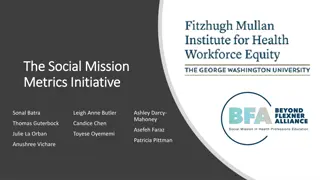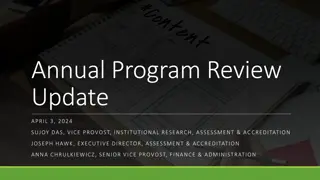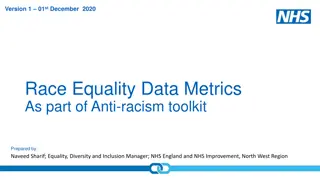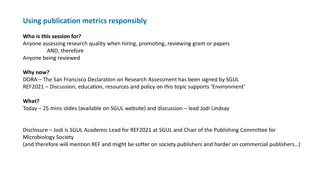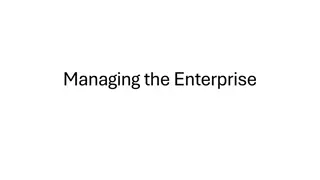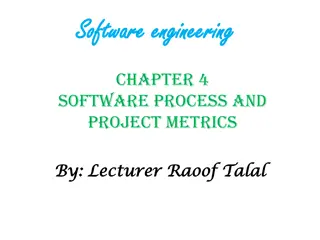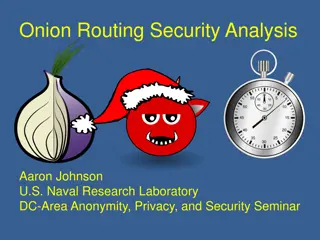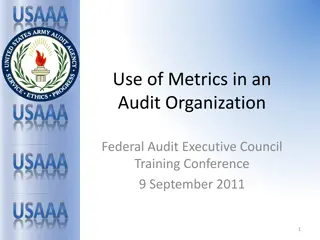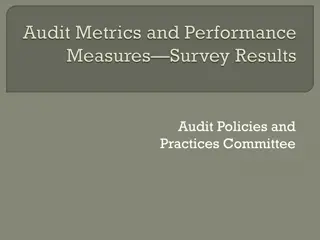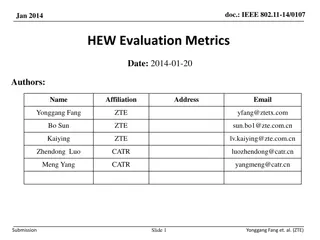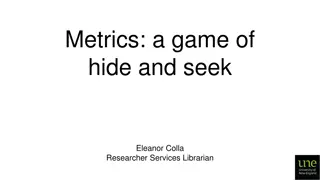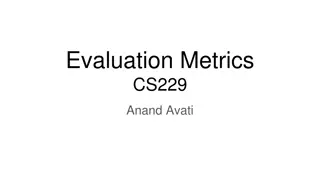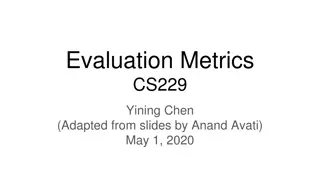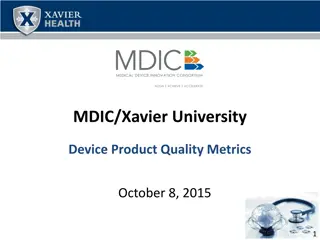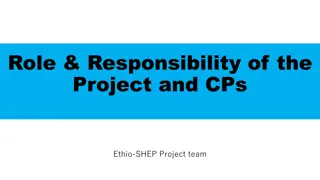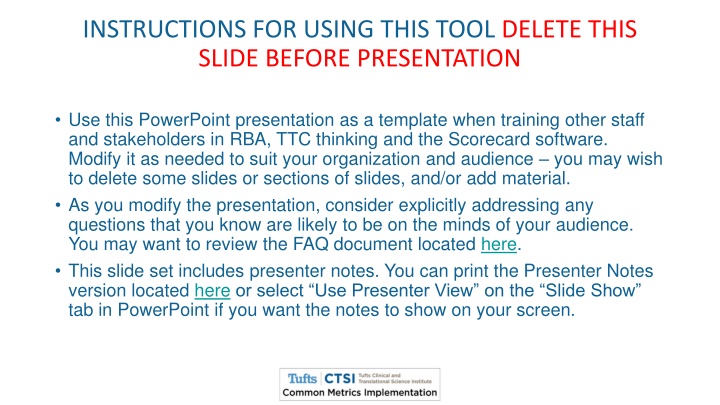
Effective Training on RBA, TTC Thinking, and Scorecard Software
Utilize this PowerPoint template for training staff and stakeholders in RBA, TTC thinking, and Scorecard software. Tailor the content to your organization's needs, addressing common questions and enhancing understanding. Delete unnecessary slides, add relevant information, and engage your audience effectively.
Uploaded on | 1 Views
Download Presentation

Please find below an Image/Link to download the presentation.
The content on the website is provided AS IS for your information and personal use only. It may not be sold, licensed, or shared on other websites without obtaining consent from the author. If you encounter any issues during the download, it is possible that the publisher has removed the file from their server.
You are allowed to download the files provided on this website for personal or commercial use, subject to the condition that they are used lawfully. All files are the property of their respective owners.
The content on the website is provided AS IS for your information and personal use only. It may not be sold, licensed, or shared on other websites without obtaining consent from the author.
E N D
Presentation Transcript
INSTRUCTIONS FOR USING THIS TOOL DELETE THIS SLIDE BEFORE PRESENTATION Use this PowerPoint presentation as a template when training other staff and stakeholders in RBA, TTC thinking and the Scorecard software. Modify it as needed to suit your organization and audience you may wish to delete some slides or sections of slides, and/or add material. As you modify the presentation, consider explicitly addressing any questions that you know are likely to be on the minds of your audience. You may want to review the FAQ document located here. This slide set includes presenter notes. You can print the Presenter Notes version located here or select Use Presenter View on the Slide Show tab in PowerPoint if you want the notes to show on your screen.
The Common Metrics Initiative Strategic Management of CTSA Hubs & The CTSA Consortium
Learning Objectives By the end of this training, you will be able to: Describe the goals and objectives of the Common Metrics Initiative for the strategic management of hubs and the CTSA consortium List the three initial Common Metrics Define ways that using the Results-Based Accountability Framework will enhance the Common Metrics initiative Identify the 5 steps of a Turn-the-Curve process Use basic Scorecard software functions
The Common Metrics Initiative Significant improvement in research translation & workforce development More and better treatments and cures To more patients faster at the least cost possible
The Common Metrics Initiative Data driven focus Rewards collaboration and information sharing A culture of innovation
The First Three Common Metrics
The Initial Common Metrics* 1. Median IRB Review Duration (Time from IRB submission to IRB approval) *additional CMs will be released over time
The Initial Common Metrics* 1. Median IRB Review Duration (Time from IRB submission to IRB approval) 2. Pilot Funding Publications and Subsequent Funding *additional CMs will be released over time
The Initial Common Metrics* 1. Median IRB Review Duration (Time from IRB submission to IRB approval) 2. Pilot Funding Publications and Subsequent Funding 3. Careers in Clinical and Translational Research *additional CMs will be released over time
How Will the Common Metrics be Used? 1. Define the desired impact of the CTSA Program s support and innovations 2. Gauge the extent to which that impact is occurring 3. Answer questions of contribution/attribution 4. Define or compare performance
Results-Based Accountability Framework
Why Use a Framework? A common language Facilitate a strong structure Skills and techniques to address implementation More interactive communication and participation
What is RBA? A simple, disciplined approach to decision making at every level Identifies and measures the desired impact Collaborative development and implementation of strategies to produce greatest possible impact
Common Metrics = Data/Feedback on Impact Effort/How much? Impact/Better off? What activities, services, and/or resources do we perform/provide ? What is the desired impact of those activities/servic es/resources on/for those customers? How are we doing at achieving that desired impact? Who are our customers? Common Metrics What PIs/NCATS want to track
How will RBA Be Used with the Common Metrics? 1. Align decision-making across the CTSA Program 2. Focus decision-making on the Common Metrics 3. Standardize the use of data and analysis to determine what will work to turn the curve for the Common Metrics 4. Make decision-making collaborative and transparent 5. Share with and learn from other stakeholders at the hubs and across the Network
Ends to Means Approach Work backwards to the Means Start with the End Turn the Curve ? Change the trend?
Steps in the Turn-the-Curve (TTC) Thinking Process 1. How are we doing? 2. What is the story behind the curve? 3. Who are partners that might have a role to play in turning the curve? 4. What would work to turn the curve? 5. What is our strategy to turn the curve?
A Disciplined Approach to Decision Making Turn-the-Curve Thinking Turn the Curve ? Work backwards to the Means Start with the End Change the trend? How are we doing? we headed? Where are STRATEGY What are we going to do? Why? Who can help? Options?
Step 1 Baseline and Forecasting Historical Forecast
How Are We Doing? Turning the Curve Return on Investment* OK? Forecast History Baseline History and Forecast * The ROI is not financial, it is the change in the trend line. 21
Step 2 Story Behind the Curve Root Causes (ask Why? five times) Tools that can be used: Force Field Analysis, Process Map, Driver Diagram, Cause and Effect Diagram Positive and negative current and anticipated internal and external Prioritize Which are the most important to address to turn the curve? Do we need additional data/analysis?
Step 3 Identifying Partners Who are partners who might have a role to play in turning the curve? Does the story behind the curve suggest any new partners?
Step 4 Brain Storming Solutions Identify what would work to turn the curve Discuss the following with partners Does the strategy address one or more of the root causes you have identified? Are the proposed actions evidence-based? Have no-cost/low-cost options been developed?
Step 5 Developing an Action Plan Identify most impactful strategies Conducting Feasibility Analysis Assess the impact of strategies in Turning the Curve Plan activities to accomplish those strategies
A Turn-the-Curve Example
TTC Example Example Turn The Curve Plan
Forecasting You can create a Forecast line on the Turn the Curve page The Edit Forecast button allows you to plot a forecast visually on the graph Once you click the Forecast button, a forecast edit bar will appear at the top of the graph section You can add additional points to drag and drop them in the pattern you choose
Forecasting Click Save on the forecast manage bar when you are done to save the forecast so it will always appear on the graph
Summary RBA as a strategic management methodology Turn The Curve thinking process Ends to Means Forecast Story Behind The Curve, What Works, Partners and Action Plan Scorecard as a communication tool

